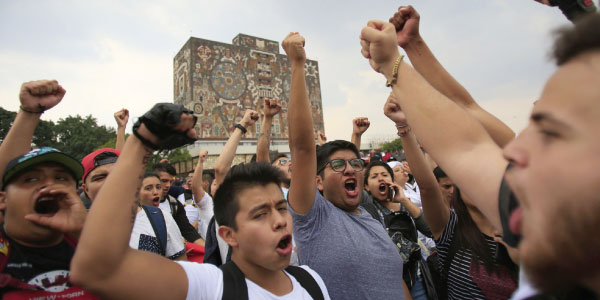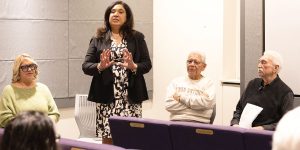
By Angie Baldelomar
On Sept. 5, thousands of students at the National Autonomous University of Mexico (UNAM), the largest and most prestigious public higher education institution in the country, marched to protest a recent campus attack against protesters.
The students also were demanding an end to violence by groups of thugs who are often registered but don’t attend classes. Also known as “porros,” the groups are associated with internal political organizations and used to violently break up protests.
The Sept. 5 protest was staged after a porro group showed up to beat a group of students from the CCH Azcapotzalco – a high school affiliated with the UNAM. On Sept. 3, the high school students protested in front of the university’s main administrative building, demanding such conditions as safer conditions and free speech.
The university has announced that 18 of the alleged attackers have been expelled. Enrique Graue Wiechers, UNAM rector, said the attack had been staged by people “who represent outside interests that evidently want to destabilize the university.” He did not offer specifics.
Students, however, were upset, claiming the university’s security officials didn’t bother to stop the attacks on Sept. 3.
The strike and march come on the 50th anniversary of a student pro-democracy movement rally that was truncated by the massacre of students by troops on Oct. 2, 1968. For decades, the massacre became a rallying cry for anti-government activists.
_____________________________________________________________________________________________
Estudiantes en México marchan para protestar la violencia de los porros
El 5 de septiembre, miles de estudiantes de la Universidad Nacional Autónoma de México (UNAM), la institución pública de educación superior más grande y prestigiosa del país, marcharon para protestar contra un reciente ataque en el campus contra manifestantes.
Los estudiantes también exigían el fin de la violencia por parte de grupos de matones que a menudo están registrados pero no asisten a clases. También conocidos como “porros”, los grupos están asociados con organizaciones políticas internas y se utilizan para dividir violentamente las protestas.
La protesta del 5 de septiembre se llevó a cabo después de que un grupo porro apareciera para aporrear a un grupo de estudiantes del CCH Azcapotzalco, una escuela secundaria afiliada a la UNAM. El 3 de septiembre, los estudiantes de secundaria protestaron frente al principal edificio administrativo de la universidad, exigiendo condiciones tales como condiciones más seguras y libertad de expresión.
La universidad ha anunciado que 18 de los presuntos atacantes han sido expulsados. Enrique Graue Wiechers, rector de la UNAM, dijo que el ataque fue organizado por personas “que representan intereses externos que evidentemente quieren desestabilizar la universidad”. No ofreció detalles.
Los estudiantes, sin embargo, estaban molestos, alegando que los oficiales de seguridad de la universidad no se molestaron en detener los ataques del 3 de septiembre.
La huelga y la marcha se producen en el 50 aniversario de una manifestación de estudiantes en favor del movimiento democrático que fue truncada por la masacre de estudiantes por las tropas el 2 de octubre de 1968. Durante décadas, la masacre se convirtió en un grito de guerra para activistas antigubernamentales.










